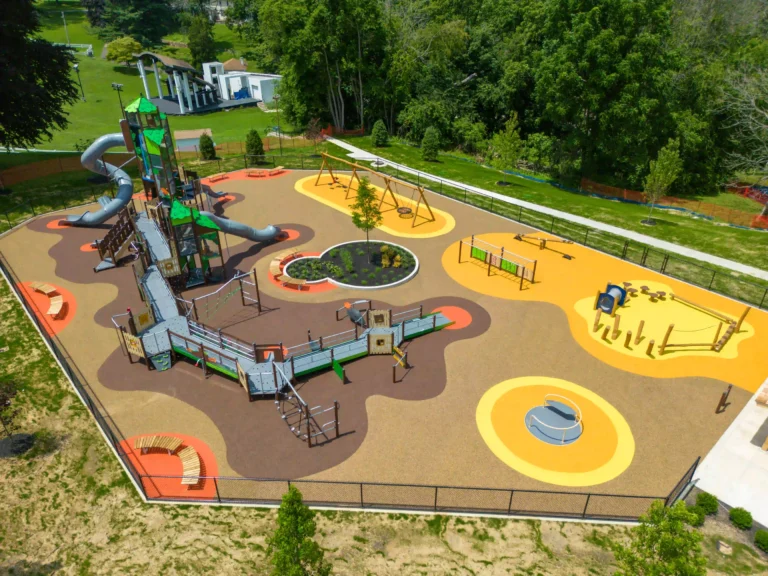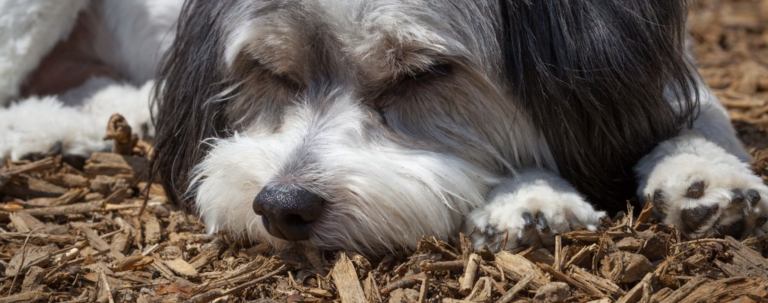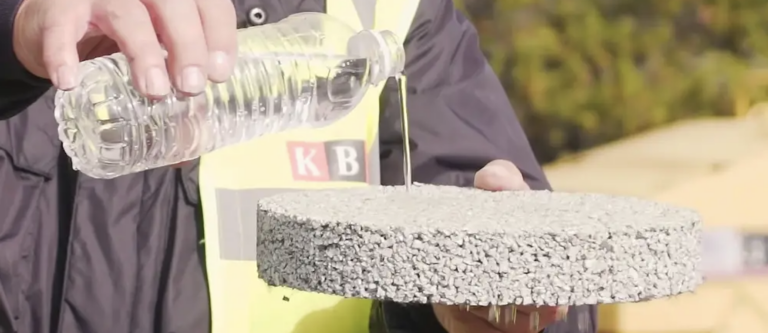Pour-in-place rubber surfacing is a versatile and durable solution, widely recognized for its utility in various applications. The primary component of this material is rubber derived from tires, which contributes to its resilience and adaptability. It is noteworthy that there are variations in the source of this rubber, which can significantly impact the quality and safety of the surfacing.
Some installers opt for rubber obtained from recycled tires that have previously been used on the road. While this approach is commendable for its recycling aspect, it may pose concerns regarding potential exposure to hazardous chemicals and contaminants accumulated during the tire’s lifecycle.
At Custom Park Surfacing, we take pride in distinguishing ourselves by exclusively using rubber that has never been utilized on the road. The rubber we incorporate is sourced directly from the trimmings produced during the manufacturing process at tire factories. This practice ensures that the rubber is pristine, uncontaminated, and devoid of any exposure to harmful substances.
By adopting this approach, we not only uphold our commitment to environmental sustainability but also prioritize the safety and well-being of the end-users of our surfaces. Our clients can rest assured that the pour-in-place rubber surfacing provided by Custom Park Surfacing is of the highest quality, meeting stringent safety standards, and free from any risk of exposure to dangerous chemicals.
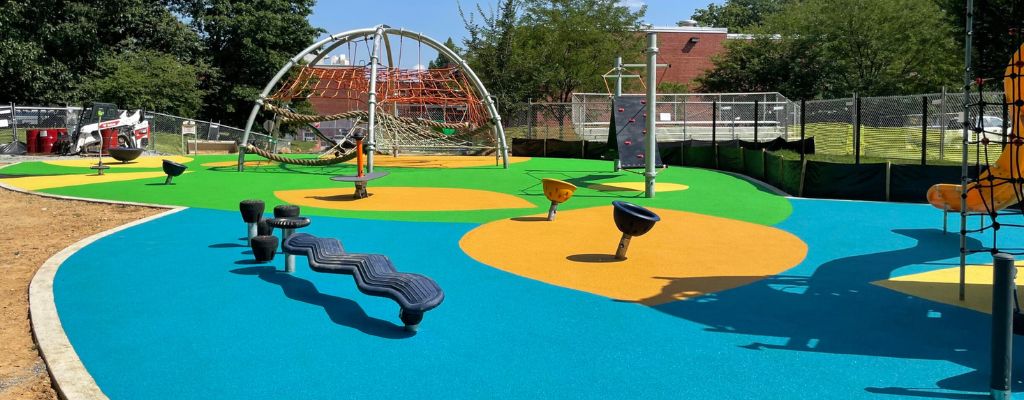
What Is Pour-In-Place Rubber Made Of?
Poured-in-place (PIP) rubber surfacing is a popular choice for playgrounds, walkways, and other outdoor spaces due to its durability, safety, and accessibility. The composition of poured-in-place rubber involves two main components:
Rubber Granules:
Base Layer: The base layer consists of larger, shredded rubber granules, typically derived from recycled tires. This layer provides shock absorption and cushioning, which is especially important in playgrounds to minimize the risk of injury from falls.
Top Layer: The top layer utilizes smaller, colored EPDM (Ethylene Propylene Diene Monomer) rubber granules. EPDM rubber is a synthetic elastomer known for its durability, flexibility, and UV resistance. The color and design of the surface are determined by the EPDM granules used in this layer.
Binder:
A polyurethane binder is used to adhere the rubber granules together, creating a solid, seamless surface once cured. The binder ensures the stability and longevity of the surfacing.
The installation process involves mixing the rubber granules with the binder and then pouring the mixture onto the prepared surface area. It is then troweled to the desired thickness and smoothed out. The surface is left to cure, resulting in a durable, resilient, and permeable rubber surface suitable for various applications.
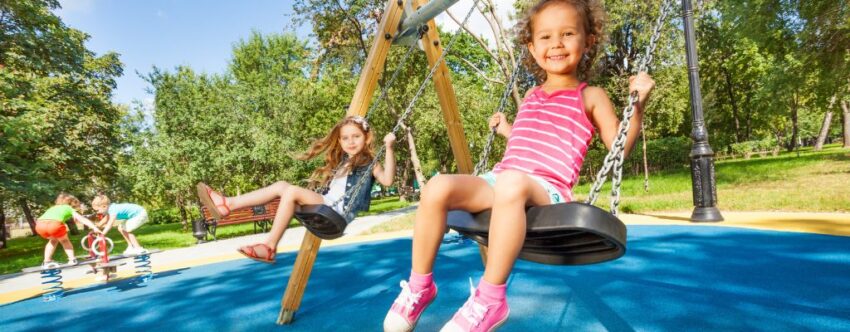
What Are The Benefits Of Pour In Place Rubber?
Poured-in-place (PIP) rubber surfacing offers a multitude of benefits, making it a preferred choice for playgrounds, walkways, and various recreational areas. Here are some of the key benefits:
– Safety
PIP rubber offers a cushioned and impact-absorbent surface, significantly reducing the risk of injuries from falls. It meets various safety standards such as CSA and ASTM, making it an ideal choice for playgrounds and other areas where safety is paramount.
– Accessibility
The seamless nature of PIP rubber surfacing ensures it is wheelchair accessible and ADA-compliant, facilitating easy movement for individuals with mobility challenges and making recreational areas more inclusive.
– Durability and Longevity:
With its ability to withstand heavy use, various weather conditions, and UV exposure, PIP rubber is highly durable and long-lasting. This durability translates to cost-effectiveness over time, as the surface requires less frequent replacement compared to other materials.
How Long Does Pour In Place Rubber Last?
Poured-in-place (PIP) rubber surfacing is known for its durability and longevity. When properly installed and maintained, it can last for around 8 to 12 years, and in some cases, even longer. The lifespan of PIP rubber surfacing can be influenced by several factors, including the quality of materials, installation, usage and maintenance.
How Do You Maintain Pour In Place Rubber?
Maintaining poured-in-place (PIP) rubber surfacing is relatively straightforward and involves regular cleaning and timely repairs to ensure its longevity and safety. Here are some general maintenance guidelines:
– Regular Cleaning
Sweep or blow off the surface regularly to remove loose debris, leaves, and dirt.
Wash the surface with mild soap and water as needed to remove stains and spills. Avoid using harsh or abrasive cleaners that could damage the surface.
Rinse thoroughly with clean water after washing.
– Spot Cleaning
Address spills and stains promptly to prevent them from setting.
For stubborn stains, use a soft-bristled brush and mild detergent, then rinse thoroughly.
– Weed and Moss Control
Periodically inspect the edges and seams of the surface for any signs of weed or moss growth.
Remove any vegetation promptly to prevent it from taking root and damaging the surface.
– Inspection for Damage
Regularly inspect the surface for any signs of wear, tear, or damage, such as cracks, holes, or loose granules.
Pay special attention to high-traffic areas and spots under play equipment where wear may be more pronounced.
– Timely Repairs
Address minor damages promptly to prevent them from worsening.
Contact a professional for repair if you notice significant damage or if the surface is nearing the end of its lifespan.
– Avoiding Sharp Objects and Heat
Discourage the use of sharp objects, high heels, or heavy equipment on the surface to prevent punctures and indentations.
Avoid placing hot objects, such as barbecue grills, on the surface to prevent melting or damage.
– Water Drainage
Ensure that the surrounding area has proper water drainage to prevent water pooling on the surface.
Remove standing water after heavy rainfall to reduce slip hazards and prolong the life of the surface.
– Seasonal Care
In winter, use plastic shovels for snow removal to avoid damaging the surface.
Avoid using harsh de-icing chemicals; instead, use sand or cat litter for traction if needed.
By following these maintenance guidelines, you can help preserve the appearance, safety, and longevity of the poured-in-place rubber surfacing. Additionally, always refer to the manufacturer’s specific maintenance recommendations and guidelines for the best care practices.
Get Pour In Place Rubber Installed By Custom Park Surfacing
Are you seeking a surfacing solution that combines safety, durability, and aesthetic appeal? Look no further! At Custom Park Surfacing, we specialize in providing top-quality poured-in-place (PIP) rubber surfacing, tailored to meet your unique needs and vision.
Why Choose Custom Park Surfacing?
- Unmatched Safety: Our PIP rubber surfaces are designed to minimize the risk of injuries, meeting CSA and ASTM safety standards.
- Eco-Friendly Options: We pride ourselves on using pristine, never-used rubber trimmings directly from tire factories, ensuring a clean and environmentally sustainable product.
- Vibrant Customization: Bring your vision to life with a myriad of colors and custom designs, enhancing the visual appeal of your space.
- Long-Lasting Durability: Invest in a surface that stands the test of time, withstanding weather conditions and heavy use.
Contact Us Today!
Reach out to our dedicated team at Custom Park Surfacing for a consultation and quote. Let’s discuss how we can create a vibrant, safe, and durable surface that exceeds your expectations!
Email: info@custompark.net
Phone: (410) 760-8200

